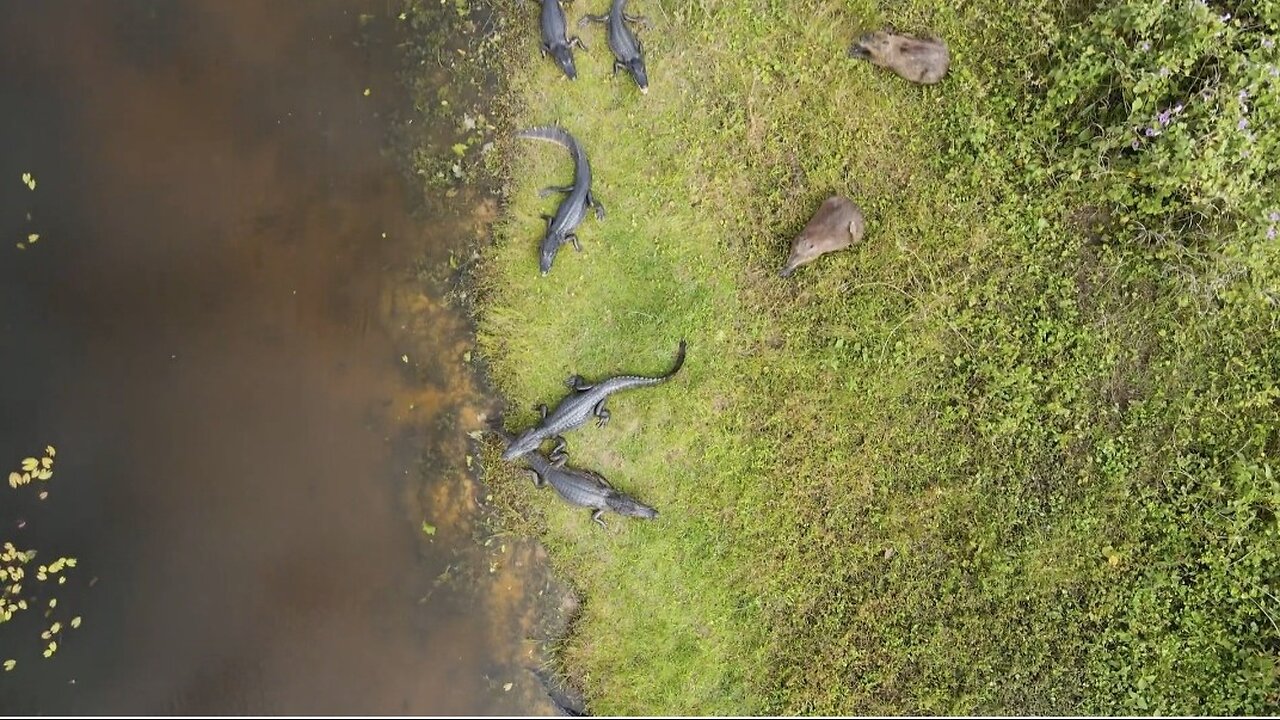Premium Only Content

"Crocodiles: Ancient Predators of the Wild"
Crocodiles are large, predatory reptiles that belong to the family Crocodylidae. They are found in tropical regions of Africa, Asia, the Americas, and Australia, primarily inhabiting rivers, lakes, wetlands, and sometimes saltwater regions. They are ancient animals, having existed for over 200 million years, making them one of the closest living relatives of dinosaurs. Here's a detailed look into their characteristics, behavior, and ecology:
1. Physical Characteristics
Size and Appearance: Crocodiles vary in size depending on the species. The largest, the saltwater crocodile (Crocodylus porosus), can grow up to 23 feet (7 meters) in length and weigh over 2,200 pounds (1,000 kg). Smaller species, like the dwarf crocodile, grow to about 5-6 feet (1.5-1.8 meters). They have a V-shaped snout, powerful jaws, rough scaly skin, and a long, muscular tail that aids in swimming.
Teeth: Crocodiles have strong, conical teeth designed to grip prey. They can have up to 80 teeth at any given time, and if a tooth breaks off, it can be replaced with a new one throughout their lives. They do not chew their food but rather tear it apart and swallow large chunks.
Eyes and Ears: Their eyes and ears are positioned on the top of their head, allowing them to stay submerged underwater while keeping an eye on their surroundings. Crocodiles also have excellent night vision, helping them hunt in low light conditions.
2. Habitat and Distribution
Crocodiles are semi-aquatic reptiles that spend much of their time in water but can move swiftly on land when necessary. They prefer freshwater habitats such as rivers, lakes, and swamps, although some species, like the saltwater crocodile, can also thrive in brackish and marine environments.
They are primarily found in tropical and subtropical regions, with significant populations in Africa, Southeast Asia, northern Australia, and parts of Central and South America.
3. Diet and Hunting Behavior
Crocodiles are carnivorous apex predators. Their diet consists of fish, birds, mammals, and even other reptiles. Large species can take down bigger prey, such as antelope, buffalo, and sometimes even humans.
They are ambush predators, lying in wait in the water near the shore. When prey comes near, they use their powerful jaws to drag it underwater, drowning it before consuming it. Their remarkable strength, speed in short bursts, and patience make them highly effective hunters.
Crocodiles can also go long periods without eating, sometimes weeks or even months, due to their slow metabolism.
4. Reproduction and Life Cycle
Crocodiles are egg-laying reptiles. Females build nests near water sources, laying anywhere from 20 to 80 eggs, depending on the species. The sex of the hatchlings is determined by the temperature of the nest during incubation. Warmer temperatures produce males, while cooler temperatures produce females.
Crocodile mothers are known for their protective behavior. They guard the nest and, once the eggs hatch (after 2-3 months), they carry the babies to the water in their mouths. The young are vulnerable to predators, so the mother will stay with them for some time to ensure their safety.
Crocodiles have long lifespans, with some living 70 years or more in the wild.
5. Adaptations
Thermoregulation: Being cold-blooded, crocodiles depend on external heat sources to regulate their body temperature. They often bask in the sun to warm up and retreat into the water or shade to cool down.
Respiration: Crocodiles can hold their breath underwater for extended periods, sometimes up to an hour. They have specialized muscles that allow them to control buoyancy and move stealthily without surfacing.
Dermal Armor: Their tough, scaly skin acts as natural armor, providing protection from physical harm and minimizing water loss, which is vital for their survival in hot climates.
6. Species
There are about 14 species of crocodiles, some of the most well-known being:
Nile Crocodile (Crocodylus niloticus): Found across sub-Saharan Africa, the Nile crocodile is one of the largest and most aggressive species.
Saltwater Crocodile (Crocodylus porosus): Found in Southeast Asia and northern Australia, this is the largest living reptile species.
American Crocodile (Crocodylus acutus): Found in Central America, the Caribbean, and southern Florida, this species prefers coastal areas and mangrove swamps.
Dwarf Crocodile (Osteolaemus tetraspis): The smallest crocodile species, found in West Africa, growing to about 5-6 feet.
7. Behavior and Communication
Crocodiles are often solitary, but during the mating season or when food is plentiful, they may gather in larger groups. They are known for their aggressive territorial behavior, especially males.
They communicate using a variety of vocalizations, such as growls, roars, and hisses. Young crocodiles also make chirping sounds to alert their mother when they are ready to hatch.
-
 8:42
8:42
Dangerous Freedom
15 hours agoThe M&P Competitor SHREDS—But Did Smith & Wesson Screw It Up?
841 -
 1:12:50
1:12:50
MTNTOUGH Fitness Lab
15 hours agoSTOP Living in Fear: Why Some People Rise From Tragedy AND OTHERS DON'T | Ryan Manion
219 -
 8:03
8:03
Alabama Arsenal
1 day ago $0.02 earnedWoox Bravado | Modern Features Meet Timeless Style
2231 -
 49:43
49:43
Vedic compatability astrology
12 hours agoCoffee w/ Kingpins Katie Haley & Her Book!
571 -
 2:49:10
2:49:10
TimcastIRL
12 hours agoElon Musk Says X Hit By MASSIVE Cyberattack From Ukraine, Rumble Hit Too w/Ben Davidson| Timcast IRL
227K124 -
 2:05:10
2:05:10
Kim Iversen
15 hours agoFree Speech for Me, But Not for Thee: Trump Admin’s Protester Crackdown Sounds MAJOR Alarms
87.1K471 -
 1:29:26
1:29:26
Glenn Greenwald
15 hours agoICE Detains Permanent Resident for Protesting Israel; European Leaders Make Maniacal Rearmament Vows They Cannot Keep | SYSTEM UPDATE #421
156K294 -
 1:02:56
1:02:56
Donald Trump Jr.
17 hours agoUSAID Slush Fund Slashed, X Cyberattack, Plus Interview with Nate Morris | Triggered Ep.223
149K186 -
 5:48:40
5:48:40
Dr Disrespect
20 hours ago🔴LIVE - DR DISRESPECT - THE SHOTTY BOYS - WARZONE, PUBG, FORTNITE
259K43 -
 2:12:50
2:12:50
Adam Carolla
22 hours agoDouble Murder Convict to be executed by Firing Squad + Comedian Elon Gold + Comedian Carol Leifer
104K22